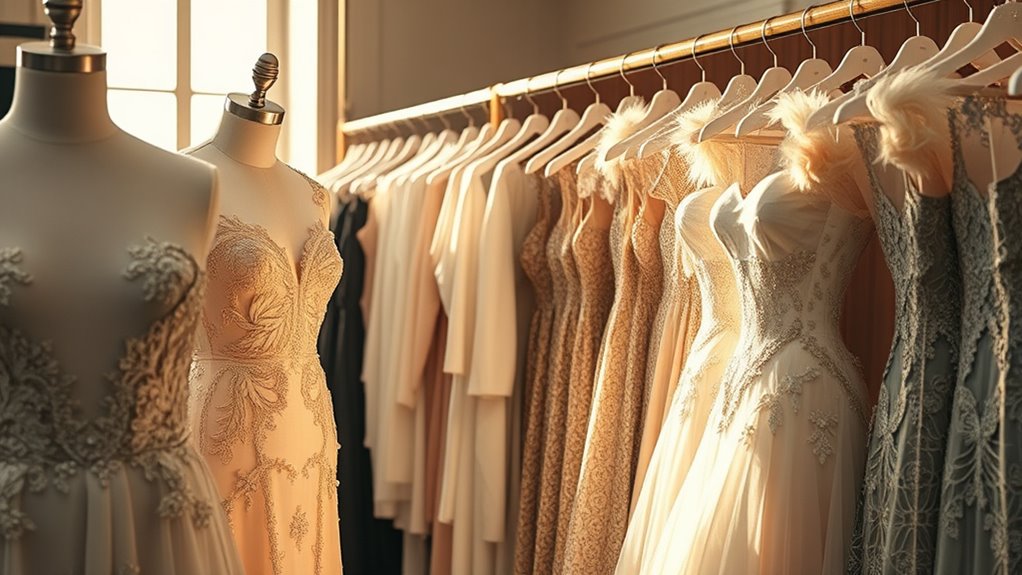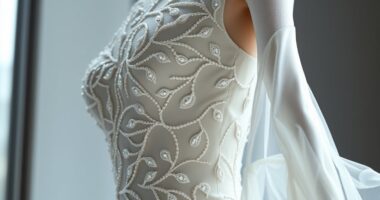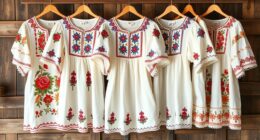To be officially recognized as haute couture in France, your fashion house must meet strict legal criteria, including creating made-to-measure garments entirely by hand for individual clients, employing a dedicated team of skilled artisans, and showcasing exclusive collections during Paris Fashion Week that highlight traditional craftsmanship and originality. Certification guarantees high standards and maintains the prestige linked to haute couture. To understand all the requirements and standards involved, keep exploring what defines this elite status.
Key Takeaways
- Must meet strict criteria established by French law, including craftsmanship and production standards.
- Produces made-to-measure, entirely handmade garments exclusively for individual clients.
- Presents two haute couture collections annually at Paris Fashion Week, demonstrating originality and quality.
- Proves historical roots and ongoing commitment to traditional haute couture practices.
- Holds official certification that guarantees adherence to industry standards and preserves prestige.

Ever wondered what truly sets a fashion house apart as haute couture in France? It’s not just about creating beautiful garments; it’s about establishing a standard that elevates a brand to the highest tier within the fashion industry. When a house qualifies as haute couture, it signifies more than just luxury branding—it represents a commitment to craftsmanship, exclusivity, and innovation that adheres to strict legal standards set by French law. These standards are designed to protect the prestige and integrity of haute couture and ensure that clients receive garments that are made with exceptional skill and attention to detail.
To meet these criteria, a fashion house must satisfy several key legal requirements. First, it must produce made-to-measure garments exclusively for individual clients. This means every piece is tailored specifically for each customer, emphasizing the bespoke nature of haute couture. The garments must be entirely handmade by skilled artisans, showcasing the craftsmanship that defines the industry’s standards. Mass production or pre-made collections simply don’t qualify. The law also mandates that the house employs a minimum number of staff—at least 20 people—dedicated to the design and creation of these custom pieces. This staffing requirement ensures a commitment to quality and the specialized skills needed for haute couture.
Haute couture requires bespoke, handmade garments crafted by at least 20 skilled artisans.
Furthermore, a house must present two haute couture collections each year during Paris Fashion Week. These collections are scrutinized for their originality, craftsmanship, and adherence to tradition, reinforcing the house’s role as a leader within the luxury fashion landscape. The legal qualification also depends on the house’s ability to prove its historical roots and ongoing commitment to the traditions of haute couture. This isn’t just about following rules; it’s about maintaining a reputation built on excellence that aligns with the industry standards recognized worldwide. Additionally, the use of traditional craftsmanship techniques is essential to uphold the authenticity of haute couture.
Being officially recognized as haute couture elevates a fashion house’s luxury branding, positioning it as a symbol of exclusivity and superior quality. It guarantees clients that they’re investing in garments crafted with unparalleled skill, using the finest materials, and embodying the artistry that sets haute couture apart from other fashion segments. It’s a mark of prestige that assures adherence to the rigorous standards that have been established over decades. Ultimately, qualifying as haute couture in France is about more than legal compliance—it’s about upholding a tradition of excellence that defines the very essence of luxury in the fashion industry.
Frequently Asked Questions
Can a New Fashion House Become Haute Couture Instantly?
You can’t become haute couture instantly. Your fashion house’s reputation and industry certification process matter most. To qualify, you must demonstrate exceptional craftsmanship, create made-to-order pieces, and have a proven history of exclusive, high-quality designs. The certification process involves meeting strict criteria set by the Chambre Syndicale de la Haute Couture. Building your reputation and going through this rigorous process takes time, dedication, and consistent excellence.
How Many Pieces Must a Couture Collection Include Annually?
You need to create at least 50 pieces in your Couture craftsmanship fashion collection each year. This collection size demonstrates your commitment to maintaining the high standards associated with haute couture. By focusing on quality and artistry, you’ll meet the legal requirements that distinguish true haute couture from other fashion lines. Keep in mind, consistency and craftsmanship are essential to uphold your status and ensure your collections stay true to haute couture traditions.
Is There a Specific Geographic Location Required for Haute Couture Houses?
You might wonder if haute couture houses need to be located in specific areas. In France, they typically operate within regional fashion hubs or designated couture districts like Paris. These districts provide a recognized space for haute couture, but the law mainly focuses on craftsmanship, exclusivity, and meeting couture standards. So, while location matters for tradition and visibility, it’s not the only factor that qualifies a house as haute couture.
Are Online-Only Couture Brands Recognized Under French Law?
Imagine stepping into a domain where digital exclusivity reigns, and virtual runway shows dazzle from screens worldwide. You might wonder if online-only couture brands qualify under French law. While traditional haute couture demands physical ateliers and bespoke craftsmanship, some online brands are gaining recognition through innovative virtual showcases, blending artistry with technology. Still, legal status remains nuanced, requiring strict adherence to French regulations, even in the digital sphere.
What Happens if a House Fails to Meet Couture Standards?
If a house fails to meet couture standards, you face significant legal consequences and cultural implications. You might lose your official status, damaging your reputation and credibility in the fashion world. This could lead to legal actions from authorities, fines, or restrictions on using the “haute couture” label. The cultural impact is also profound, as it undermines the trust consumers place in genuine couture, risking your brand’s legacy.
Conclusion
In the end, understanding what makes a house truly haute couture goes beyond just meeting legal criteria. It’s about the craftsmanship, exclusivity, and creative innovation that define the tradition. While laws set the foundation, it’s the artistry and heritage that elevate a house to haute couture status. So, if you believe in the power of tradition and craftsmanship, you’ll see that authenticity often surpasses legal definitions, reinforcing that haute couture is as much an art as it is a legal designation.










